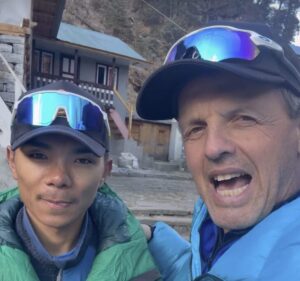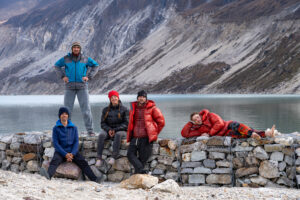This has been a strange climbing season in Nepal. Bad weather and lots of snow thwarted many teams in September and October, both on 8,000m peaks and more technical lower ones.
In addition, a number of tragic events and public criticism about crowding and too much support on popular mountains have spoiled some of the fun. Now that the attempt on Cho Oyu’s south side has ended prematurely, it seems that the season is over. Yet some last-minute surprises may still be possible.
Manaslu
At first, the main questions were who and how many would reach the true summit of Manaslu, and how the crowds would deal with that final ridge. There were 404 permits issued for the mountain, a record for Manaslu and almost an overall record for a single mountain in Nepal. Only Everest, with 408 permits this past spring, had more.

A section of the huge Manaslu Base Camp. Photo: Adriana Brownlee
In the end, crowds were only a partial problem, and the true summit turned out to be simpler than anticipated. It was a question of ropes. Official numbers are not in yet, but estimates suggest 80 to 100 summits.
Kristine Harila, aiming to climb all 14×8,000’ers in six months, was the first international climber to summit, a week after the rope-fixing team. Pasdawa Sherpa and Dawa Ongchu supported her.
But tragedy overshadowed the good news. The avalanche between Camp 4 and Camp 3 on September 26 caught at least nine people and killed one. Then Hilaree Nelson died while skiing down from the summit that same day. After this, some continued to push and summited despite dangerous conditions. Others waited in Base Camp and finally left.
The Manaslu season has revealed how the perception and management of objective risks differed radically between teams. Ultimately, the final decision of all teams was to cancel their expeditions and descend in very dangerous conditions. Some clients escaped the worst of the avalanche peril by taking helicopters from Camp 2.
‘Lowering’ the mountain
Ralf Dujmovits, a high-altitude expert who hoped to reach Manaslu’s true summit in order to clean up his 14×8,000m resumé, commented on the different strategies and conditions required for no-O2 and O2-supported climbers. While he had to retreat because of high winds and snow, “a few climbers using supplementary oxygen reached the summit despite the high winds, but some paid the heavy price of frostbite,” he noted.
Dujmovits says that for climbers, extra oxygen can reduce the height of 8,163m Manaslu down to the equivalent of 6,000m or 6,500m. He also said that Manaslu is not the easiest 8,000m peak anymore. That’s not just because of the dicey final ridge, but because of the steep sections among the seracs. Some of these areas are exposed to serac collapse and avalanches.
“Those who had little or no real mountain experience found these steep sections very difficult both technically and physically, despite the fixed ropes,” he said. These slow climbers caused much of the crowding on the lower half of the route.

Menacing seracs on Manaslu. photo: Ralf Dujmovits
Crowds, failure, fatalities
Specialized media tended to cover the crowding, overuse of helicopters, waste management, and other topical issues more than praising the mountaineering. Even blogger Alan Arnette posted an open letter asking policy decision-makers to take action on several of these issues.
Commercial expeditions have lost much of their allure among wider audiences, amid reports of inexperienced climbers and the overuse of oxygen and Sherpa support. At times, climbers waited for days in higher camps, sipping oxygen non-stop. Local guides and support staff again outnumbered the foreigners. The summit push strategies, especially the final one on Manaslu, hinted at a lack of planning. However, many climbers reported that failure was due to faulty weather forecasts.
Only Sajid Sadpara of Pakistan was confirmed to have gone non-stop from Base Camp to summit, without supplementary oxygen or personal Sherpa support.
After all the teams left, there was a surprisingly speed record summit claim on Oct. 4, by Grace Tseng of Taiwan. It remains controversial due to a lack of proof. She also had huge Sherpa support for someone claiming a speed record.
But mainly, three deaths reminded everyone that mountains can never be totally tamed.

Kristin Harila atop Manaslu. Photo: Kristin Harila
Ama Dablam
After Manaslu, most commercial teams moved to Ama Dablam. It could end up with even more climbers than Manaslu. According to the latest dispatch by Nepal’s Department of Tourism, it has issued 336 permits for foreigners so far. True, Manaslu had 404, but the Ama Dablam season lasts longer and there’s time for more sign-ons.
Teams usually acclimatize before heading to Base Camp so their climbs are briefer. Base Camp crews and climbing Sherpas just stay and work with one group after another. Base Camp tents remain in place until at least December. Some teams even leave them over winter.
It is not unusual in Nepal to have windows with cold yet stable weather in November. That attracts a significant number of late-season climbers.

On Ama Dablam. Photo: Chhang Dawa Sherpa/Seven Summit Treks
The enduring monsoon delayed the work on Ama Dablam. A Sherpa died during the rope-fixing but it didn’t affect the teams’ plans.
It is nearly impossible, even for those in Base Camp, to count summits on Ama Dablam. Besides, these climbs are so repetitive that while profitable for outfitters, they are not exactly riveting as mountaineering. Only once in a while does something different come along, such as Toshiyuki Yamada‘s recent speed climb.
Otherwise, Ama Dablam summiters have simply become numbers. Incidentally, according to The Himalayan Database, 5,166 people have summited Ama Dablam until the end of 2021. Of them, only 12 used supplementary oxygen. As @KrisAnnapurna noted, six of these did so in the last two years.
No-goes
Andrzej Bargiel and his team attempted Everest so that Bargiel could ski down it. Their own Sherpa team fixed the Khumbu Icefall, and a film crew hoped to turn the expedition into a documentary. In the end, the wind proved too high for Bargiel to venture beyond Camp 4. He was climbing without supplementary oxygen.

Andrzej Bargiel at Everest South Col, just before turning back. Photo: Janusz Golab
Some teams attempted Dhaulagiri in early October, but none were successful. The same is true of Cho Oyu, where high winds and avalanche danger defeated two teams that included some 14×8,000m record-seekers.
On Cho Oyu, the Sherpas only reached 7,300m, and their clients did not make it even that far. On both mountains, teams went home after just one summit push, without awaiting better conditions for a second attempt. That is a new trend with commercial teams. Although Base Camp facilities have vastly improved and clients can even catch a helicopter back to town for some luxury, climbers rarely spend over four weeks at Base Camp. In previous times, two months and several attempts were pretty standard.

The Ecuadorian team at the base of Langtang Lirung. Photo: Roberto Morales
Conditions also pushed back several smaller teams attempting difficult routes on Manaslu’s West Face, Jannu, and Langtang Lirung. Most of these teams intended to climb alpine style. For them, one failed try meant the end of the expedition, since alpine style dictates that climbers should not have been on the route before attempting it.
And now what?
Well, the climbers most active on social media are on their way home or already there. But the climbing season is not over. Nepal’s Department of Tourism has granted permits for 41 peaks over 6,500m.
Note that some of Nepal’s most popular trekking peaks are slightly lower and hence not even listed, including 6,160m Island Peak (Imja Tse) and 6,119m Lobuche East. Some of the higher trekking peaks are straightforward, with fixed ropes and usually one high camp. Others are quite interesting or, even better, unknown.

List of peaks for which climbing permits have been issued this season. Source: Nepal’s Department of Tourism
For instance, Czech Zdenek Hak is leading a team on 6,859m Chumbu in the Khumbu Valley. It is not far from Ama Dablam and just a few metres south of the Tibetan border. They are currently in Base Camp at 5,700m, waiting for good conditions.
After Langtang Lirung, Roberto Morales will lead an Alpenglow team to scenic Cholatse, a difficult peak from all sides. They will try the Southwest Ridge.






